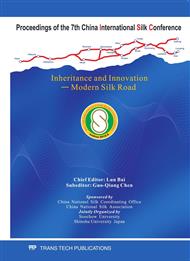p.717
p.722
p.729
p.735
p.740
p.745
p.750
p.755
p.760
A Novel Non-Azobenzene Based Metal Complex Dye for Silk Fabric
Abstract:
The past decade has been marked by a growing interest in the development and use of ecologically friendly dyes. In this paper, a novel non-azobenzene ligand, (Z)-4-amino-2-(4-carboxyphenyl)-5-(hydroxyimino)-2,5-dihydro-1H-imidazole 3-oxide, was synthesized by the reaction of 3,4-diaminoglyoxime with 4-formylbenzoic acid, and characterized by IR, 1H-NMR and MS. The values of the 1H-NMR spectral results were in harmony with previously reported (Z)-4-amino-5-(hydroxyimino)-2,5-dihydro-1H-imidazole 3-oxide derivatives. Its brown ferrous complex has been prepared conveniently and applied to dye silk fabric. From the IR spectra of the complex, the stretching vibration for the ring of imidazole was disappeared, and the C=N absorption was lower than that of the ligand, which indicated that the N,N-chelate coordination bond was formed and the participation of the C=N-OH group in metal coordination. The colour fastness values of the dyed silk fabric to light, washing and rubbing were measured. The washing fastness of dyed silk fabric can reach 4 grade or 4-5 grade; the rub fastness 3-5 grade; the light fastness 3 grade.
Info:
Periodical:
Pages:
740-744
Citation:
Online since:
January 2011
Authors:
Keywords:
Price:
Сopyright:
© 2011 Trans Tech Publications Ltd. All Rights Reserved
Share:
Citation:


